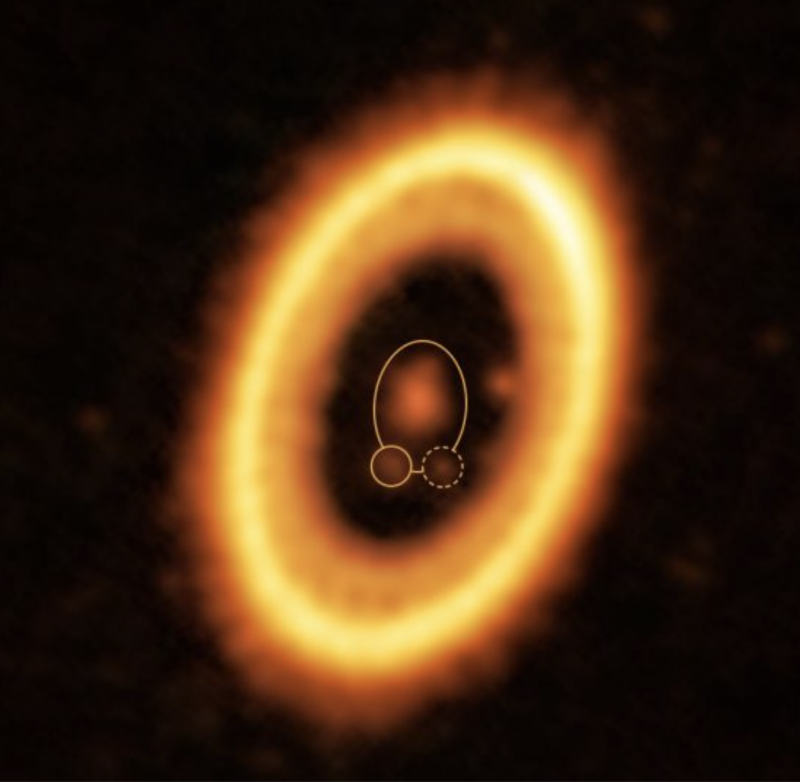
Can 2 planets share an orbit?
Astronomers have long thought that two planets could share an orbit. The idea is sometimes seen in science fiction. And, on July 19, 2023, the European Southern Observatory released this image from the ALMA telescope in Chile, showing what might be two planets – or at least the closest we’ve seen to two planets – in a single orbit around a star.
The large golden ring is a disk of material out of which the planets are forming. The star – at the center of the ring – is called PDS 70. And one of the objects in orbit is most certainly a planet. It’s called PDS 70b. The 2nd object might be a cloud of debris. It might be the building blocks of a new planet, or the remnants of one already formed.
What’s more, scientists see yet another planet here – PDS 70c – in the 3 o’clock position next to the disk.
Lead author Olga Balsalobre-Ruza of the Center for Astrobiology in Madrid, Spain, said:
Two decades ago it was predicted in theory that pairs of planets of similar mass may share the same orbit around their star, the so-called Trojan or co-orbital planets.
For the first time, we have found evidence in favor of that idea.
The team published their peer-reviewed study in the journal Astronomy and Astrophysics on July 19, 2023.
Solar system Trojans and exo-Trojans
Our own solar system is home to Trojans, or rocky bodies that share an orbit with a planet. For example, the Trojan asteroids of Jupiter orbit in front of and behind the gas giant. And even Earth has Trojan asteroids. So astronomers didn’t think it was a stretch that similar Trojan-type objects might exist in other solar systems. They just hadn’t found any yet. Jorge Lillo-Box, also of the Center for Astrobiology, said:
Exo-Trojans have so far been like unicorns: they are allowed to exist by theory but no one has ever detected them.
So an international team of scientists decided to search for exo-Trojans around PDS 70 using archival data from ALMA. The young star had two known Jupiter-like planets: PDS 70b and PDS 70c. But the team spotted “a cloud of debris” in the orbit of PDS 70b. And it was right where they’d expect Trojans to exist.
Lagrange points 4 and 5 are the stable regions in a planet’s orbit that lead and follow the planet, respectively. And these two zones are where the tug of gravity from the star and planet allows material to accumulate. The researchers found a cloud of debris with a mass equal to two Earth moons in one of PDS 70b’s Lagrange zones. So, it may be an existing Trojan world or one in the making. Balsalobre-Ruza said:
Who could imagine two worlds that share the duration of the year and the habitability conditions? Our work is the first evidence that this kind of world could exist. We can imagine that a planet can share its orbit with thousands of asteroids as in the case of Jupiter, but it is mind blowing to me that planets could share the same orbit.
Confirming the co-orbiting planets
These possible sibling planets may go by a variety of names, such as Trojan planets and co-orbiting or co-orbital planets. And now researchers have the first ones in their sights. Nuria Huélamo, also of the Center for Astrobiology, said:
Our research is a first step to look for co-orbital planets very early in their formation.
Itziar de Gregorio-Monsalvo of ESO said:
It opens up new questions on the formation of Trojans, how they evolve and how frequent they are in different planetary systems.
Confirmation won’t come until 2026, when they’ll be able to use ALMA to see how far the planet and its sibling have moved in their orbit. Balsalobre-Ruza said:
This would be a breakthrough in the exoplanetary field.
De Gregorio-Monsalvo added:
The future of this topic is very exciting, and we look forward to the extended ALMA capabilities, planned for 2030, which will dramatically improve the array’s ability to characterize Trojans in many other stars.
Bottom line: Can two planets share an orbit? Astronomers have long believed they could, and a new image is finally providing photographic evidence of the possibility.
Read more: The Lucy mission will visit Jupiter’s Trojan asteroids and more











